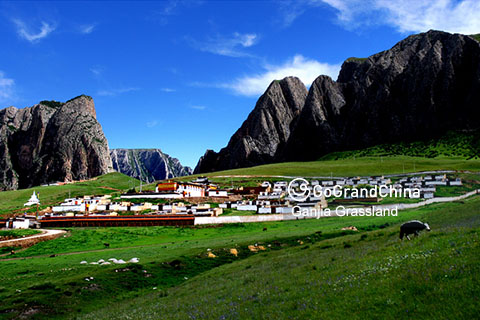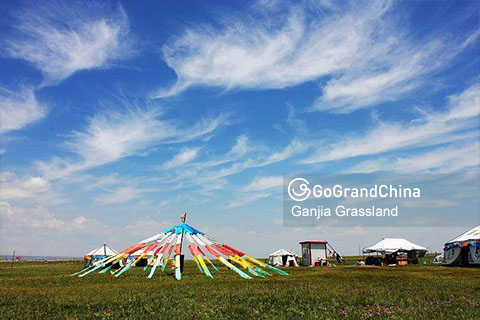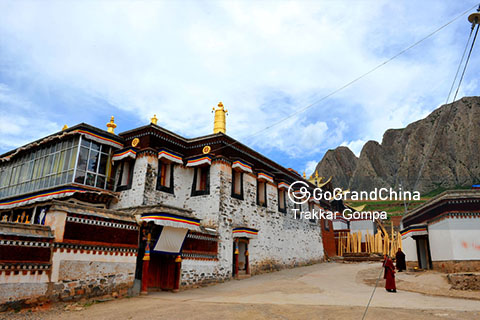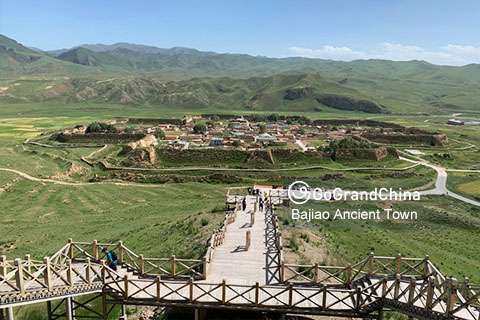You have no items in your shopping cart.
Ganjia Grassland
Introducing Ganjia Grassland
Ganjia Grassland is a picturesque Tibetan steppe that lies 34 kilometers (21 miles) north of Xiahe County. Herds of sheep and yaks graze peacefully on the lush expanse, their presence adding to the stunning beauty of the landscape. It was here, amidst the tranquility of the rolling hills, that Ngawang Tsondru, the first Jamyang Zheaypa and founder of Labrang Monastery, was born.
Today, Ganjia Grassland remains deeply intertwined with local culture and economy. Its boundless grasslands, at an average elevation exceeding 3,000 meters (9,842 ft), make it one of the most important animal husbandry bases in the Gannan Tibetan Autonomous Prefecture. This, combined with its natural beauty, has made it one of the region’s most attractive tourist destinations.
Ganjia Grassland Fast Facts
• Chinese Name: Gan Jia Cao Yuan 甘加草原
• Best Time to Visit: July to August
• Recommended Visiting Hours: 2 - 3 x hours
• Things to Do: Photography, Nature, Tibetan Buddhism
• Opening Hours: All day
• Entrance Fee: Free
• Address: Approx. 34 km (21.1 miles) north of Xiahe County, Gannan Tibetan Autonomous Prefecture, Gansu Province
What to Expect at Ganjia Grassland
Ganjia Grassland offers the perfect escape from the everyday hustle, inviting you to reconnect with nature in a breathtaking setting. Here, you can set your own pace: live alongside Tibetan herders, explore on horseback or an ATV excursion, and embark on journeys to time-honored monasteries and caves for a truly awe-inspiring experience.
The nomad life of Tibetans
In Ganjia Grassland, traditional Tibetan life thrives as nomadic families continue their age-old practice of herding livestock. These welcoming herders are happy to share their unique way of life with visitors, offering a glimpse into their daily routines and traditions from milking yaks to crafting butter tea. Animal lovers will be charmed by the sheep, goats, yaks, and cows that graze these lands, their presence woven into the very fabric of nomadic life.


Trakkar Gompa
Set against high vertical rock formations, the Trakkar Gompa (Baishiya Monastery), meaning “White Stone Cliff Monastery,” was founded in the 14th century. Home to over 90 Buddhist monks, it remains an active place of worship, housing various Buddha statues like Shakyamuni and Tara. The monastery also safeguards a rich collection of Buddhist scriptures and relics, including the Kangyur, the stupa of Yogi Kucho Rinpoche, and a sandalwood mandala of Chakrasamvara. These impeccably preserved treasures continue to benefit generations of devotees.


Bajiao Ancient Town
Visit the 2000-year-old Han dynasty town of Bajiao, whose remarkable 12-sided walls still shelter a small living community. Bajiao Ancient Town preserves a large number of cultural relics from the Southern and Northern Dynasties (420 BC - 589 BC) to Qing dynasty, which explains the development history of the ancient Silk Road Henan Road.
Baishiya Karst Cave
Baishiya Karst Cave, recognized as the site of the Xiahe mandible (the earliest hominin fossil found on the Tibetan Plateau), gained further significance when paleoproteomic analysis confirmed the mandible to be Denisovan, marking the first discovery of Denisovan remains outside of Denisova Cave. This finding proves that archaic hominins inhabited high-altitude environments as far back as 160,000 years ago.
Baishiya Karst Cave is also a revered Tibetan Buddhist sanctuary, believed to have been inhabited by Padmasambhava and the bodhisattva Tara. It serves as a popular location for monastic fasting and meditation, a pilgrimage site for Tibetan Buddhists, and a tourist attraction.
How to get to Ganjia Grassland
• The Ganjia Grassland is located approx. 34 km (21.1 miles) away from Xiahe County.
• Charter a car/bus from GGC to enjoy a hassle-free private transfer to the Ganjia Grassland.
There are no products matching the selection.

